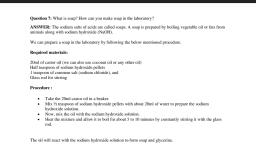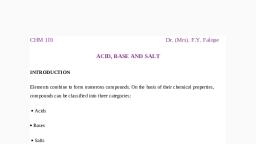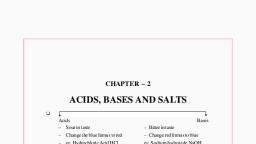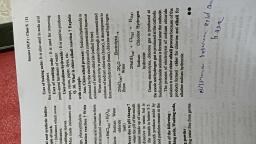Page 1 :
CHAPTER -7 ACID, BASE AND SALTS CLASS- VII, SCIENCE, , D. LONG ANSWER QUESTIONSQuestion 3: Some acids are dangerous, other are not. Explain, giving examples., , ANSWER: Acids can be classified into mineral acids and organic acids., , Most of the mineral acids are strong and corrosive in nature. They are extremely dangerous to handle. Strong, acids (highly concentrated due to less amount of water in them) can easily melt paper, wool, wood and cloth. If, they come in contact with our skin, they cause severe burns to it (carbonic acid is an exception in this case)., Since strong acids can corrode even metals like iron, aluminium, etc., they are stored in glass containers., Hence, we should be highly cautious while handling strong acids., , Examples: Hydrochloric acid, nitric acid, sulphuric acid, etc., , Organic acids are naturally occurring weak acids. They are non-corrosive in nature, and are safe to handle even, in their concentrated state., , Examples: Acetic acid (present in vinegar), Lactic acid (present in milk), Citric acid (present in citrus fruits),, etc., , Question 4: What are bases? What are their physical properties?, , ANSWER: Bases are substances that have a soapy feel and bitter taste. Bases help in neutralizing the acidity, by forming salt and water., , Like acids, bases can also be strong and weak. Sodium hydroxide and potassium hydroxide are strong bases, which can burn our skin; but magnesium hydroxide and copper hydroxides are weak bases, and safe to handle, even in their concentrated state., , Some of the properties of bases are listed below:, 1. Most of the bases are metal hydroxides., , 2. They are bitter in taste., , 3. They are soapy in touch., , 4. They turn red litmus blue., , 5. Their reaction with acids gives salt and water., , Question 5: Give two main uses each of, , (a) calcium hydroxide, (b) ammonium hydroxide, (c) sodium hydroxide, , ANSWER: Two important uses of each base are stated below:, , (a) Calcium hydroxide [Ca(OH)2]:, , 1. It is used to whitewash buildings; it is also used as an alternative to cement in low-budgeted construction., , 2. It is also used to neutralise the acidity of soil. Because of the over usage of chemical fertilisers, soil becomes., acidic and hence largely affects the growth of crops. Thus, calcium hydroxide is added to the soil to neutralise, its acidity, thereby ensuring the healthy growth of the crops., , (b) Ammonium hydroxide (NH:OH):, , , , 1. Itis widely used to produce fertiliser like ammonium nitrate., 2. It is also used to produce nylons, plastics, dyes, etc., , (c) Sodium hydroxide (NaOH):, , 1. It is extensively used in the production of soaps., 2. It is used to produce various medicines, rayon, paper, etc., , Question 6: State two methods by which salts can be prepared. Give one example of each., , ANSWER: Salts which are neutral substances can be prepared from the following methods:, 1. Neutralization Reaction — It is the reaction between an acid and a base to produce salt, water and heat., , Example: Hydrochloric acid reacts with sodium hydroxide to produce sodium chloride (common salt), water, and heat., , 2. Reaction of metals with acids - Metals react with acids to replace hydrogen from the acids, thereby, producing salts and liberating hydrogen gas., , Example: Zinc reacts with dilute sulphuric acid to form zinc sulphate salt liberating hydrogen gas., The reaction is given below:, , Zn + dil H2SOs > ZnSO4 + H2O















































